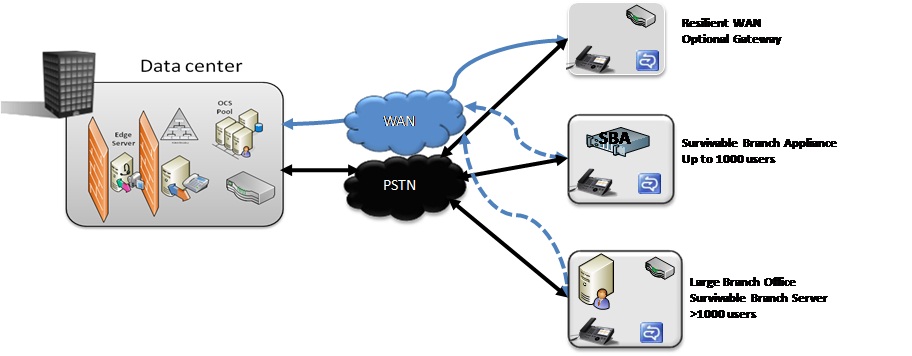Topic Last Modified: 2010-07-14
There are obvious advantages to providing branch-site resiliency to your organization, namely that if you lose the connection to the central site, branch site users will continue to have Enterprise Voice service and voicemail (if you configure voicemail rerouting settings; for more information, see Branch-Site Resiliency Requirements). However, for sites with fewer than 25 users a resiliency solution may not provide return on investment.
If you decide to provide branch-site resiliency, you have three options for how to do so. Use the following table to help you determine which option is right for you.
| If you… | We recommend that you use a… |
|---|---|
|
Host between 25 and 1000 users at your branch site, and if the return on investment does not support a full deployment or where local administrative support is unavailable |
Survivable Branch Appliance |
|
Host between 1000 and 5000 users at your branch site, lack a resilient WAN connection, and have trained Communications Server admins available |
Survivable Branch Server |
|
Host more than 5000 users at your branch site and have trained Communications Server admins available |
Full-scale Communications Server 2010 deployment at the branch
site and an IP/PSTN gateway or SIP trunk |
Resiliency Topologies
The following figure shows the recommended topologies for branch-site resiliency.

Survivable Branch Appliance Details
The Communications Server 2010 Survivable Branch Appliance includes the following components:
- A Registrar for user authentication, registration and call
routing
- A Mediation Server for handling signaling between the Registrar
and an IP-PSTN gateway
- An IP-PSTN gateway for routing calls to the PSTN as a fallback
transport in the event of a WAN outage
- SQL Server Express for local user data storage
The Survivable Branch Appliance also includes PSTN trunks, analog ports, and an Ethernet adapter.
The following figure shows the basic architecture of the Survivable Branch Appliance.

If the branch site’s WAN connection to a central site becomes unavailable, internal branch users should continue to be registered with the Survivable Branch Appliance Registrar and obtain uninterrupted voice service using the Survivable Branch Appliance’s connection to the PSTN. Remote branch site users should be able to register with a Registrar server at a central site. When the WAN connection becomes available, full functionality should be restored to branch site users. Neither the failover to the Survivable Branch Appliance nor the restoration of service requires the presence of an IT administrator.
Survivable Branch Appliance Deployment Overview
The Survivable Branch Appliance is manufactured by original equipment manufacturers in partnership with Microsoft and deployed on their behalf by value added retailers. This deployment should occur only after Communications Server 2010 has been deployed at the central site, a WAN connection to the branch site is in place, and branch site users are enabled for Enterprise Voice.
For detailed information about these phases, see Deploying a Survivable Branch Appliance or Server, in the Deployment Guide.
| Phase | Steps | Permissions |
|---|---|---|
|
Install prerequisite software |
At the central site:
|
The technician must belong to the RTCUniversalSBATechnicians
group. |
|
Install, and activate the Survivable Branch Appliance. |
At the branch site:
|
The technician must belong to the RTCUniversalSBATechnicians group. |
Survivable Branch Server Details
Install the Survivable Branch Server the same way you install any Communications Server role.
 See Also
See Also

